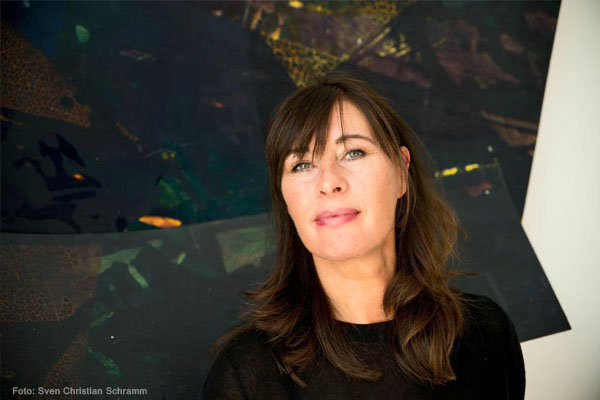
“We all create culture, every day … in terms of our thinking,
our actions and our decisions.”
Petra Seebauer
Following the success of her design studio in Munich, Petra Seebauer took a
position with the International Building Fair in Berlin. In addition to the
realization of her own artistic vision, she also worked as a set designer for a
number of diverse movie productions and continued her creative experiments
with a special focus on the relationship between space and object. During that
phase she was intensely involved in commercial product design and the
development
of her own product lines and labels. Today, she divides her time
between Berlin and Washington, DC. Her conceptual approach to art
includes
objects, multiples, paintings and installations.
Interview Petra Seebauer
You live and work in Berlin. What influence did the Russian constructivists have on you?
I would call it some sort of “Wow” moment. Art doesn’t stop with panel painting, but
rather the constructive elements of architecture are carried on in pictorial art and vice
versa. The Bauhaus period combined all art forms and thus elevated utilitarian
objects
into expressions of an artistic vision while, at the same time, making sure that well
designed objects could be manufactured industrially.
What is the connection between the “old” Petra Seebauer and your current works?
My most pressing concern is the integration of art, architecture and design. This synthesis
is present in my current works which are on view in Washington, Berlin and Colonial Beach.
What do you think sets your vision of art apart?
Interface and structure are the biggest concerns in my perception of movement and
space. I would add “Haptik” which, to me, is an expression of sensual understanding.
How do you integrate this claim (demand?) in your art?
I start with expressive color and form in order to create movement on the surface and
then follow up by adding or removing the layers in the original composition. Through this
transformation, I achieve a sense of calmness in the movement and depth in the surface.
How do you get from surface to form? And why in the United States?
That is partly due to personal reasons and partly, because I have always been interested
in the artistic conflict with expressions in current American culture.
Can you give me a for instance?
Every aspect of creative expression is, as a rule, highly valued in the United States which
leads
to quick acceptance and implementation of concepts. Europe represents individual
diversity as the impetus to creative thought. Both together are the ideal basis for my art.
Which artists have been most instrumental in your artistic development?
Robert Rauschenberg and Jackson Pollock, Frank Lloyd Wright, but also Corbussier
and the Russian constructivists, for instance El Lissitsky, in addition to the Bauhaus.
In which way did these artists influence you?
Rauschenberg through the use and treatment of his medium and also in the way he was
able to instill a sense of the third dimension into the graphic quality of his works.
And what about the architects?
Wright through his ability to create a harmonious synchronicity between architecture in its
specific environment and also by being able to combine the external and the internal.
How do you get from surface to form?
Through the act of altering surface-type materials and the development of form and
sculptural aspects using sculptural techniques. For instance, in the area of design it
is
nowadays accepted practice to involve computer images and models.
What is the connection of the artist Petra Seebauer and Petra Seebauer, the individual?
I have transformed one of my weaknesses into a strength, i.e. I am by nature interested
in a
broad range of things which can lead to feeling unfocused. But through my
work I am able
to channel my many interests into lateral thinking and the joy of playing
with materials,
subjects
and ideas.
Excursiveness as actuation of your artistic vision?
(She smiles.) Yes, that and the need for unusual solutions?
How would you characterize yourself in a few words?
I am a strange mixture of great ambition coupled with a strong penchant for taking it easy.
How would you describe the effect of your works?
Spaces without “character” make me grumpy. A carelessly furnished hotel room can
make
me
feel quite uncomfortable. There has to be a connection (give and take?)
between the
presentation/ arrangement of
a space and the lives of the people
inhabiting that space.
Installation(s) as a contribution towards a better world?
(She laughs.) My works have surely been intended towards improvements in the quality
of
life as well as the notion that we have to become better caretakers ofresources in
our personal
lives.
This sounds very nearly spiritual?
Yes, spirituality is a very important source for inspiration in my work, but also a well from
which
I can draw the strength to overcome the limitations of my thinking and imagination.
Is this approach, at least partially, based on Buddhist precepts?
Absolutely … Through the conscious association with things with which we are in daily
contact, towards other people. towards our food and, lastly, ourselves we create a
daily quality of life. For that reason, I don’t see myself as an artist only, but more as
someone involved in the creation of art.
Can you remember your first design?
My first design was a bed. Since I didn’t have any money to have one delivered to me,
I designed one which I could put together myself. It became a rather successful design
and I sleep on mine to this day (laughs).
